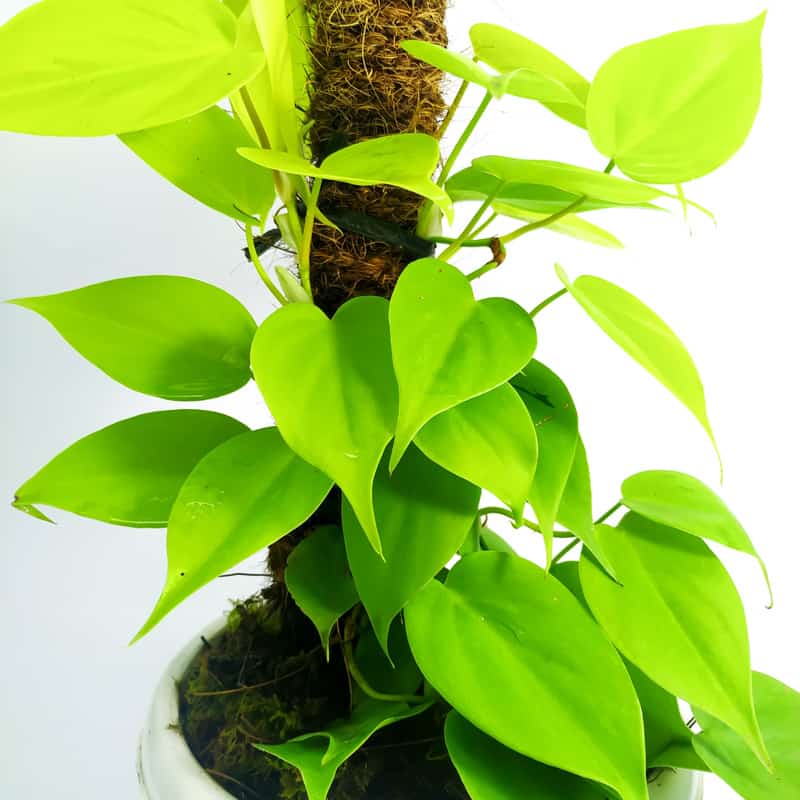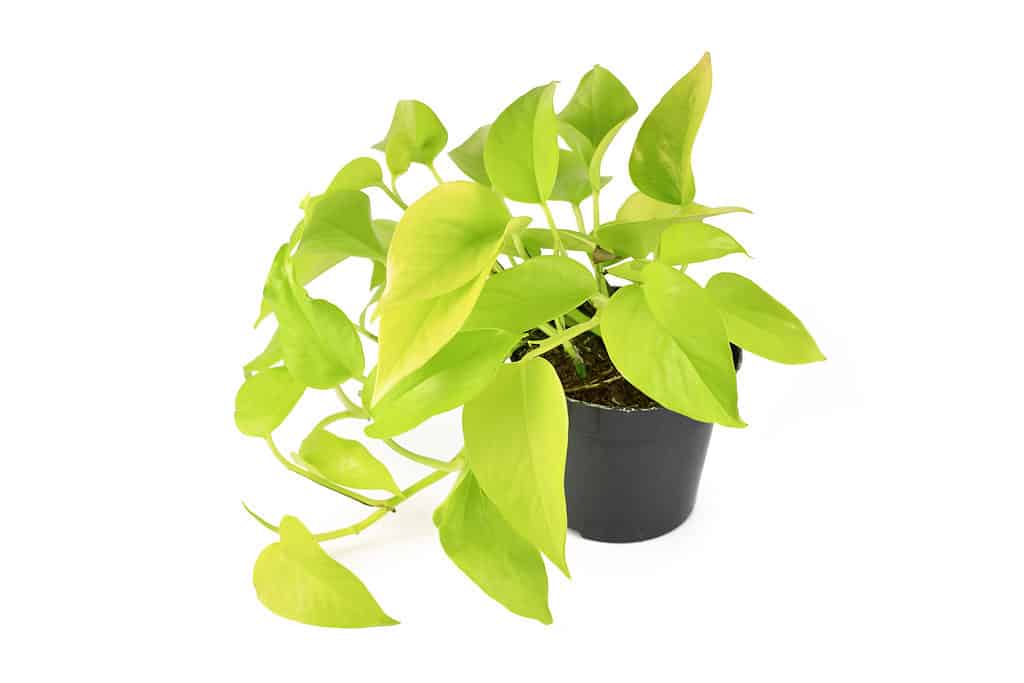A truly beautiful pothos from the Epipremnum genus, the neon pothos has notoriously vivid green and chartreuse foliage. It is considerably more vibrantly colored than other cultivars and can really pack a punch in your collection of houseplants, and it is just as simple to cultivate as the typical golden pothos.
Some varieties of pothos, such as golden pothos and jade pothos, may thrive outside of windows. Contrarily, avoid placing Epipremnum aureum ‘Neon’ in a dimly lit area since it will get greener and lose its neon coloring. Give your plant a bright window with up to half a day of sun, most of which is bright indirect light. An excellent window would be one that faces east or west, but stay away from any windows that receive direct sunlight since the color will fade.
It’s also important to remember that younger leaves have a tendency to have a somewhat brighter hue than older leaves, which have a tendency to get a little darker with age.
Let’s explore a bit more about the neon pothos, shall we?
Neon Pothos Scientific Name
Neon pothos is classified as Epipremnum aureum ‘Neon’. Like all other pothos, it is part of the Araceae family of plants. The neon pothos has chartreuse foliage that starts off as pale yellow-green and develops into a range of chartreuse to lime-green hues as it ages. If given a supporting framework, the vining stems, which can get fairly long, will climb upward. In ideal circumstances, mature stems can grow to be at least 20 feet long.
Neon Pothos Care Requirements
Neon pothos, as previously noted, require moderate watering. Give your plant some water when the top two inches of soil feel dry. Make sure the pot has openings for drainage. Pooling water can cause root rot and plant mortality.
In general, neon pothos thrive in indirect, strong light. Although they won’t grow, they will survive in lesser illumination scenarios. Their leaves will become a crispy brown when exposed to direct sunlight, even if it is coming from outside or a south-facing window. Keep in mind that they develop in the shadow of bigger trees in the wild. A little shade will help!
The soil you choose really does not matter to neon pothos. They thrive in typical potted plant soil mixtures. These plants can handle some root entanglement, but if the roots become too congested to acquire nutrients from the soil, they may slow down their development and may even begin to shed their leaves. If necessary, repot your plant into a pot that is one to two inches bigger. Avoid moving it to a pot that is too large since this might cause water to collect and root rot.
Watering
Since neon pothos plants are water-sensitive, it is advisable to let the soil dry out between waterings. Before adding additional water, the soil should be dry to about one inch into the soil. Bottom watering is a wonderful approach to make sure you don’t overwater or underwater your neon pothos plant.
Start by adding water to a plant tray. Make sure the water on the tray is in contact with the soil that is visible through the pot’s bottom drainage holes. About 10 minutes after waiting, check to see if the soil has absorbed enough water by feeling it with your finger. If the soil is extremely wet, empty the tray of any extra water. More water should be added to the tray if it’s still dry. Prior to eliminating the excess, wait another 20 minutes to see if it wants to soak up more. Salts and other minerals in the soil won’t be removed by bottom watering, so be sure to sometimes water the top of the soil as well.

Neon pothos plants (pictured) will maintain their vibrant foliage with proper watering.
©iStock.com/NooUma
Light Levels
Neon pothos is different from several other varieties of pothos in this regard since it can endure lower light levels. However, doing so will cause it to lose its vibrant coloring. The ideal light level for a neon pothos is moderate to high sunlight exposure. Just keep it away from any windows that are particularly hot or offer only direct sunlight. They’ll quickly start to burn at their leaf tips. Very bright light is okay as long as it is at least eight feet away from windows that face west or south.
If your neon pothos only receives light from one side, try rotating it occasionally. Those leaves will definitely slant in the direction of the light. Avoid growing neon pothos in reduced light circumstances if you want to preserve its vivid chartreuse color. The leaves will shrink and turn back to a solid basic shade of green. For reduced light, a jade pothos is a much better option.

Neon pothos (pictured) do be indoors if they are placed near a window with some way to dapple the incoming light.
©Genali/Shutterstock.com
Humidity and Misting
Misting is not usually necessary for pothos. It would be ideal to place a pothos on a pebble tray that can be filled with water without dampening the soil to improve humidity surrounding the plant throughout the winter. Misting the plant won’t help it stay sufficiently hydrated or in the right humidity, and it could even make it more susceptible to insect infestation. Only mist your pothos if its leaves are particularly dusty, but make sure to gently wipe off the excess from its leaves afterward.
If you want to mist to increase the humidity around the plant, consider alternative actions. We recommend placing some water in a nearby tray to boost the humidity around the plant without having to mist it.
Propagation and Growth Considerations for Neon Pothos
This variety of pothos grows moderately to quickly. The growth rate will be slower if you have it in an area with less light and cooler temperatures. A neon pothos plant can easily grow up to one foot each month under ideal conditions.
Growing a Bushier Neon Pothos
Pruning is necessary for pothos plants to get that bushy appearance. The stems will continue to trail and appear thinner if you don’t trim them. They often spread into places with even less light, which results in sparser leaves and an unsculpted appearance all around. You may give the plant the pruning it needs for the best form and to stimulate branching and bushiness.
Simply take your pruning shears and remove the stems that are growing out and down so that new leaf development begins to branch out from the top of the plant if you want to make your pothos fuller from the top. Always cut just below the nearest leaf node. This prevents any of the plant’s bare stems from not being able to grow properly. If you don’t want to throw away these prunings, don’t worry. Neon pothos are incredibly easy to propagate from cuttings, so you can make even more plants for free!
Giving your neon pothos some fertilizer is another excellent technique to make it seem bushier. Pothos are not heavy feeders and don’t need fertilizer, but you’ll need to give them a small push if you want to encourage the additional development of stems and leaves.
At least once or twice a month, you can fertilize the soil with compost or a liquid solution. The plant will seem heavier and fuller as a result of the increased development of the leaf. Pour the necessary quantity of solid fertilizer on top of the soil and use a hand trowel to gently incorporate it into the soil. Be careful not to sever any roots. To make the fertilizer work and spread evenly to the roots, water your neon pothos after fertilizing. If you’re using a liquid fertilizer, combine the required quantity of fertilizer and water in a watering can before pouring the mixture directly into the soil. To avoid burning the plant, dilute your fertilizer to approximately half-strength.
It’s critical to keep in mind that too much fertilizer might harm any plant, including the neon pothos. You can take the plant out of the soil and repot it in fresh soil if you think there may be an accumulation of fertilizer in its old soil. Alternatively, you could try soaking the soil with water and letting it drain to clear it of some accumulated fertilizer.
Keep in mind that neon pothos are climbing plants and don’t always have a very bushy appearance. It’s part of this plant’s charm!
Moss Poles for Neon Pothos
A moss pole is a robust stick or pole that has been covered with moss which helps climbing plants to grow up instead of down or sideways. It is possible for neon pothos to grow climbing, hanging, or trailing. The leaves will grow much larger and may possibly develop into a more vivid yellow neon if you let them climb! They are capable of scaling any form of trellis or moss pole. For indoor uses, a moss pole can be very useful.
Repotting a Neon Pothos
Despite the fact that pothos are hardy plants, their roots will ultimately take over the pot and start to cause issues from being rootbound. It could be time to repot your neon pothos if you find that the leaves are drooping despite the plant receiving the right quantity of water and sunlight. By gently removing your neon pothos from its pot, you can inspect the root ball and make sure that root development is the actual problem. If this is the case, move it to a little larger container and fill it with new soil that drains effectively.

Neon pothos (pictured) will start off bushy in their pots but will eventually start to have more of a vine appearance.
©Shadow Inspiration/Shutterstock.com
Neon Pothos Pests and Other Detrimental Issues
The neon pothos variety is a fantastic choice for a beginner gardener because the most frequent causes of problems are very easy to cure. There are no significant pest or disease issues with this houseplant, although mealybugs and scale may decide to make your vibrant neon pothos their home. To get rid of these pests, use cotton balls drenched in vinegar or an organic pesticide and leave them around the top of the plant’s soil. Weekly inspections can also help you avoid severe infestations. Even then, you can just rinse the mealybugs off (be sure to dry the leaves afterward!) or use a horticultural oil spray to get rid of them.
If you’re looking for the most vibrant pothos variety out there, why not give the neon pothos a try? There’s so much to love about this showy neon-green plant!
Up Next:
- Discover 3 Pothos Varieties
- Types Of Pothos: A Complete Guide
- Growing Indoor Pothos: How To Keep This Plant Happy Inside
The photo featured at the top of this post is © M.Sabouri/Shutterstock.com
Thank you for reading! Have some feedback for us? Contact the AZ Animals editorial team.






